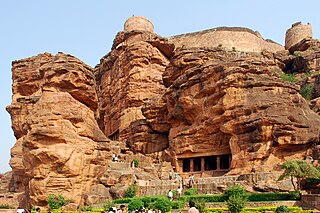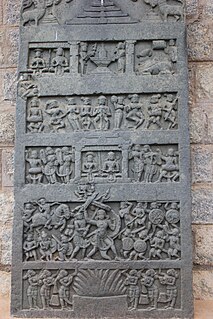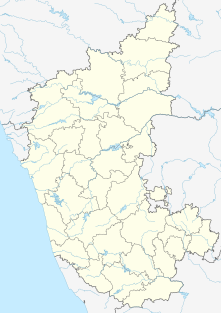
The Middle kingdoms of India were the political entities in India from the 3rd century BCE to the 13th century CE. The period begins after the decline of the Maurya Empire and the corresponding rise of the Satavahana dynasty, starting with Simuka, from 230 BCE. The "Middle" period lasted for about 1,500 years and ended in the 13th century, with the rise of the Delhi Sultanate, founded in 1206, and the end of the Later Cholas.

The Pallava dynasty was an Indian dynasty that existed from 275 CE to 897 CE, ruling a portion of southern India. They gained prominence after the eclipse of the Satavahana dynasty, whom the Pallavas served as feudatories.

The Kadambas were an ancient royal family of Karnataka, India, that ruled northern Karnataka and the Konkan from Banavasi in present-day Uttara Kannada district. The kingdom was founded by Mayurasharma in c. 345, and at later times showed the potential of developing into imperial proportions. An indication of their imperial ambitions is provided by the titles and epithets assumed by its rulers, and the marital relations they kept with other kingdoms and empires, such as the Vakatakas and Guptas of northern India. Mayurasharma defeated the armies of the Pallavas of Kanchi possibly with the help of some native tribes and claimed sovereignty. The Kadamba power reached its peak during the rule of Kakusthavarma.

Rajaraja I, born Arulmoli Varman, often described as Rajaraja the Great, was a Chola emperor chiefly remembered for reinstating the Chola power and ensuring its supremacy in south India and Indian Ocean.

Badami, formerly known as Vatapi, is a town and headquarters of a taluk by the same name, in the Bagalkot district of Karnataka, India. It was the regal capital of the Badami Chalukyas from CE 540 to 757. It is famous for its rock cut structural temples. It is located in a ravine at the foot of a rugged, red sandstone outcrop that surrounds Agastya lake. Badami has been selected as one of the heritage cities for HRIDAY - Heritage City Development and Augmentation Yojana scheme of Government of India.

Bagalkot district, is an administrative district in the Indian state of Karnataka. The district headquarters is located in the town of Bagalkot. The district is located in northern Karnataka and borders Belgaum, Gadag, Koppal, Raichur and Bijapur. The new Bagalkot district was carved out of Bijapur in 1997 via Government of Karnataka directive Notification RD 42 LRD 87 Part III. The bifurcated Bagalkot district consists of nine taluks — Badami, Bagalkot, Bilagi, Guledgudda, Rabkavi Banhatti, Hunagund, Ilkal, Jamakhandi and Mudhol.
Bunt is an Indian community, who traditionally inhabit the coastal districts of Karnataka. With agrarian origins, Bunts had a martial background and are the landed gentry of the region. The Bunts today are a largely urbanised community.

Arsikere is a town and taluka in the Hassan district in the state of Karnataka, India. This region is known for its coconut production and second largest coconut market in Karnataka after Tiptur along with Malekallu Tirupathi hill. Arsikere is the taluk headquarters, a major railway junction on the South Western Railway which links Mangalore and Mysore to North Karnataka and a central place for tourists who visit nearby places that do not have rail access, such as Belur, Halebidu and Shravanabelagola.

The Kalabhra dynasty, also called Kaḷabrar, Kaḷappirar, Kallupura or Kalvar, were rulers of all or parts of Tamil region sometime between the 3rd century and 6th century CE, after the ancient dynasties of the early Cholas, the early Pandyas and Chera. Information about the origin and reign of the Kalabhras is uncertain and scarce. Their proposed roots vary from southeast region of modern Karnataka, Kalappalars of Vellalar community, to Kalavar chieftains. The Kalabhra era is sometimes referred to as the "dark period" of Tamil history, and information about it is generally inferred from any mentions in the literature and inscriptions that are dated many centuries after their era ended.

Shimoga district, officially known as Shivamogga district, is a district in the Karnataka state of India. A major part of Shimoga district lies in the Malnad region or the Sahyadri. Shimoga city is its administrative centre. Jog Falls view point is a major tourist attraction. As of 2011 Shimoga district has a population of 1,752,753. There are seven taluks: Soraba, Sagara, Hosanagar, Shimoga, Shikaripura, Thirthahalli, and Bhadravathi.

The Alupa was an ancient ruling dynasty of India. The kingdom they ruled was known as Alvakheda Arusasira and its territory spanned the coastal districts of the modern Indian state known as Karnataka. The cultural region of Tulu Nadu was the core of their territory. The Alupas in their prime were an independent dynasty, centuries after reigning due to the dominance of Kadambas from Banavasi, they became feudatory to them. Later they became the vassals of the Chalukyas, Rashtrakutas, Hoysalas with the change in political scenario of Southern India. Their influence over coastal Karnataka lasted for about 1200 years. There is evidence that the Alupas followed the law of matrilineal inheritance (Aliyasantana) since the Alupa king Soyideva was succeeded by his nephew Kulasekhara Bankideva. The legendary king who is credited with introducing matrilineality in Tulu Nadu is named Bhuta Alupa Pandya The descendants of this dynasty still survive to this date and have spread in the karavali region and they are widely called as Bunt The Bunt community follows Matrilineality, unlike any other warrior community, they can be identified with their surnames such as Shetty, Rai, Hegde, Alva, chowta etc, even though most Bunt are hindus by faith now, The sizeable section of the community still follows Jainism and they are called Jain Bunt The last Alupa king to have ruled is Kulasekharadeva Alupendradeva whose inscription dated 1444 CE have been found in Mudabidri Jain Basadi.

Karnataka, a state in South India has a long association with Jainism, a religion which enjoyed patronage of major historic kingdoms in the state such as the Western Ganga, Kadamba and Chalukya dynasties and the Hoysala Empire. Today the state is home to a number of Jain monuments, such as temples, Gommata statues and stambhas.

A hero stone is a memorial commemorating the honorable death of a hero in battle. Erected between the 6th century BC and the 18th century AD, hero stones are found all over India. They often carry inscriptions displaying a variety of adornments, including bas relief panels, frieze, and figures on carved stone. Usually they are in the form of a stone monument and may have an inscription at the bottom with a narrative of the battle. The Earliest and oldest of such memorial Hero stones is found in the Indian state of Tamil Nadu is more than 2400 years old that is 4th Century BC. According to the historian Upinder Singh, the largest concentration of such memorial stones is found in the Indian state of Karnataka. About two thousand six hundred and fifty hero stones, the earliest in Karnataka is dated to the 5th century AD. The custom of erecting memorial stones dates back to the Iron Age though a vast majority were erected between the 4th century BC to 13th centuries AD.

Jainism in North Karnataka flourished under the Chalukyas, Kadamba, Rashtrakutas, and Vijayanagara empire. Imbued with religious feeling, patronage was extended towards the building of Jain temple and it garnered high repute among the people, particularly the ruling classes and the mercantile community; effectively getting treated as the state religion.

Malkheda, also known as Malkhed,) is a town in Karnataka, India. It is located on the banks of Kagina River in Sedam Taluk of Gulbarga district, around 40 km from Kalaburagi.
Nolamba dynasty was a minor Southern Indian dynasty. The area they held sway over is referred to as Nolambasa-37 of Henjeru (Hemavathi), Nolambalige (Nolambavadi-32000), etc. R. Narasimhacharya states that the Nolambas were a native Kannada dynasty.
Kanakatte is a village located in Arasikere taluk, Hassan district, Karnataka, India.

The Shree Vinayaka Devaru is a Hindu temple dedicated to the god Ganesha (Vinayaka), located on the West Coast of India in the Idagunji town in Uttara Kannada district in Karnataka state, India. The temple's popularity as a religious place is recorded by about 1 million devotees visiting it annually.
The Chahamanas of Shakambhari, colloquially known as the Chauhans of Sambhar, were a dynasty that ruled parts of the present-day Rajasthan and its neighbouring areas in India, between 6th and 12th centuries. The territory ruled by them was known as Sapadalaksha. They were the most prominent ruling family of the Chahamana (Chauhan) clan, and were categorized among Agnivanshi Rajputs in the later medieval legends.













